[English] 日本語
 Yorodumi
Yorodumi- PDB-8zc6: SARS-CoV-2 Omicron BA.4 spike trimer (6P) in complex with D1F6 Fa... -
+ Open data
Open data
- Basic information
Basic information
| Entry | Database: PDB / ID: 8zc6 | |||||||||||||||||||||||||||||||||||||||||||||
|---|---|---|---|---|---|---|---|---|---|---|---|---|---|---|---|---|---|---|---|---|---|---|---|---|---|---|---|---|---|---|---|---|---|---|---|---|---|---|---|---|---|---|---|---|---|---|
| Title | SARS-CoV-2 Omicron BA.4 spike trimer (6P) in complex with D1F6 Fab, head-to-head aggregate | |||||||||||||||||||||||||||||||||||||||||||||
 Components Components |
| |||||||||||||||||||||||||||||||||||||||||||||
 Keywords Keywords | VIRAL PROTEIN/IMMUNE SYSTEM / Spike protein / Antibody Fab fragment / Complex / VIRAL PROTEIN-IMMUNE SYSTEM complex | |||||||||||||||||||||||||||||||||||||||||||||
| Function / homology |  Function and homology information Function and homology informationsymbiont-mediated disruption of host tissue / Maturation of spike protein / Translation of Structural Proteins / Virion Assembly and Release / host cell surface / host extracellular space / viral translation / symbiont-mediated-mediated suppression of host tetherin activity / Induction of Cell-Cell Fusion / structural constituent of virion ...symbiont-mediated disruption of host tissue / Maturation of spike protein / Translation of Structural Proteins / Virion Assembly and Release / host cell surface / host extracellular space / viral translation / symbiont-mediated-mediated suppression of host tetherin activity / Induction of Cell-Cell Fusion / structural constituent of virion / entry receptor-mediated virion attachment to host cell / membrane fusion / Attachment and Entry / host cell endoplasmic reticulum-Golgi intermediate compartment membrane / positive regulation of viral entry into host cell / receptor-mediated virion attachment to host cell / host cell surface receptor binding / symbiont-mediated suppression of host innate immune response / receptor ligand activity / endocytosis involved in viral entry into host cell / fusion of virus membrane with host plasma membrane / fusion of virus membrane with host endosome membrane / viral envelope / symbiont entry into host cell / virion attachment to host cell / SARS-CoV-2 activates/modulates innate and adaptive immune responses / host cell plasma membrane / virion membrane / identical protein binding / membrane / plasma membrane Similarity search - Function | |||||||||||||||||||||||||||||||||||||||||||||
| Biological species |   Homo sapiens (human) Homo sapiens (human) | |||||||||||||||||||||||||||||||||||||||||||||
| Method | ELECTRON MICROSCOPY / single particle reconstruction / cryo EM / Resolution: 6.85 Å | |||||||||||||||||||||||||||||||||||||||||||||
 Authors Authors | Liu, B. / Gao, X. / Li, Z. / Chen, Q. / He, J. / Xiong, X. | |||||||||||||||||||||||||||||||||||||||||||||
| Funding support | 3items
| |||||||||||||||||||||||||||||||||||||||||||||
 Citation Citation |  Journal: Cell Rep / Year: 2024 Journal: Cell Rep / Year: 2024Title: An unconventional VH1-2 antibody tolerates escape mutations and shows an antigenic hotspot on SARS-CoV-2 spike. Authors: Banghui Liu / Xuefeng Niu / Yijun Deng / Zhaoyong Zhang / Yanqun Wang / Xijie Gao / Huan Liang / Zimu Li / Qian Wang / Yuanyi Cheng / Qiuluan Chen / Shuangshuang Huang / Yingxian Pan / ...Authors: Banghui Liu / Xuefeng Niu / Yijun Deng / Zhaoyong Zhang / Yanqun Wang / Xijie Gao / Huan Liang / Zimu Li / Qian Wang / Yuanyi Cheng / Qiuluan Chen / Shuangshuang Huang / Yingxian Pan / Mengzhen Su / Xiancheng Lin / Chuanying Niu / Yinglin Chen / Wenyi Yang / Yudi Zhang / Qihong Yan / Jun He / Jincun Zhao / Ling Chen / Xiaoli Xiong /  Abstract: The severe acute respiratory syndrome coronavirus 2 (SARS-CoV-2) spike (S) protein continues to evolve antigenically, impacting antibody immunity. D1F6, an affinity-matured non-stereotypic VH1-2 ...The severe acute respiratory syndrome coronavirus 2 (SARS-CoV-2) spike (S) protein continues to evolve antigenically, impacting antibody immunity. D1F6, an affinity-matured non-stereotypic VH1-2 antibody isolated from a patient infected with the SARS-CoV-2 ancestral strain, effectively neutralizes most Omicron variants tested, including XBB.1.5. We identify that D1F6 in the immunoglobulin G (IgG) form is able to overcome the effect of most Omicron mutations through its avidity-enhanced multivalent S-trimer binding. Cryo-electron microscopy (cryo-EM) and biochemical analyses show that three simultaneous epitope mutations are generally needed to substantially disrupt the multivalent S-trimer binding by D1F6 IgG. Antigenic mutations at spike positions 346, 444, and 445, which appeared in the latest variants, have little effect on D1F6 binding individually. However, these mutations are able to act synergistically with earlier Omicron mutations to impair neutralization by affecting the interaction between D1F6 IgG and the S-trimer. These results provide insight into the mechanism by which accumulated antigenic mutations facilitate evasion of affinity-matured antibodies. | |||||||||||||||||||||||||||||||||||||||||||||
| History |
|
- Structure visualization
Structure visualization
| Structure viewer | Molecule:  Molmil Molmil Jmol/JSmol Jmol/JSmol |
|---|
- Downloads & links
Downloads & links
- Download
Download
| PDBx/mmCIF format |  8zc6.cif.gz 8zc6.cif.gz | 1.4 MB | Display |  PDBx/mmCIF format PDBx/mmCIF format |
|---|---|---|---|---|
| PDB format |  pdb8zc6.ent.gz pdb8zc6.ent.gz | 1.2 MB | Display |  PDB format PDB format |
| PDBx/mmJSON format |  8zc6.json.gz 8zc6.json.gz | Tree view |  PDBx/mmJSON format PDBx/mmJSON format | |
| Others |  Other downloads Other downloads |
-Validation report
| Summary document |  8zc6_validation.pdf.gz 8zc6_validation.pdf.gz | 946.6 KB | Display |  wwPDB validaton report wwPDB validaton report |
|---|---|---|---|---|
| Full document |  8zc6_full_validation.pdf.gz 8zc6_full_validation.pdf.gz | 1010.9 KB | Display | |
| Data in XML |  8zc6_validation.xml.gz 8zc6_validation.xml.gz | 154.6 KB | Display | |
| Data in CIF |  8zc6_validation.cif.gz 8zc6_validation.cif.gz | 240 KB | Display | |
| Arichive directory |  https://data.pdbj.org/pub/pdb/validation_reports/zc/8zc6 https://data.pdbj.org/pub/pdb/validation_reports/zc/8zc6 ftp://data.pdbj.org/pub/pdb/validation_reports/zc/8zc6 ftp://data.pdbj.org/pub/pdb/validation_reports/zc/8zc6 | HTTPS FTP |
-Related structure data
| Related structure data |  39924MC 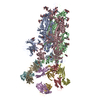 8zbyC  8zbzC 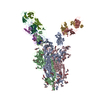 8zc0C 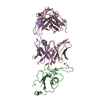 8zc1C  8zc2C  8zc3C  8zc4C 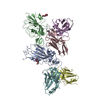 8zc5C M: map data used to model this data C: citing same article ( |
|---|---|
| Similar structure data | Similarity search - Function & homology  F&H Search F&H Search |
- Links
Links
- Assembly
Assembly
| Deposited unit | 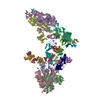
|
|---|---|
| 1 |
|
- Components
Components
| #1: Protein | Mass: 137621.516 Da / Num. of mol.: 6 Mutation: 681-684del, F817P, A892P, A899P, A942P, K986P, V987P Source method: isolated from a genetically manipulated source Source: (gene. exp.)  Strain: Omicron/BA.4 / Gene: S, 2 / Cell line (production host): HEK293 / Production host:  Homo sapiens (human) / References: UniProt: P0DTC2 Homo sapiens (human) / References: UniProt: P0DTC2#2: Antibody | Mass: 23623.270 Da / Num. of mol.: 6 Source method: isolated from a genetically manipulated source Source: (gene. exp.)  Homo sapiens (human) / Cell line (production host): HEK293 / Production host: Homo sapiens (human) / Cell line (production host): HEK293 / Production host:  Homo sapiens (human) Homo sapiens (human)#3: Antibody | Mass: 24752.727 Da / Num. of mol.: 6 Source method: isolated from a genetically manipulated source Source: (gene. exp.)  Homo sapiens (human) / Cell line (production host): HEK293 / Production host: Homo sapiens (human) / Cell line (production host): HEK293 / Production host:  Homo sapiens (human) Homo sapiens (human)#4: Sugar | ChemComp-NAG / Has ligand of interest | Y | Has protein modification | Y | |
|---|
-Experimental details
-Experiment
| Experiment | Method: ELECTRON MICROSCOPY |
|---|---|
| EM experiment | Aggregation state: PARTICLE / 3D reconstruction method: single particle reconstruction |
- Sample preparation
Sample preparation
| Component | Name: SARS-CoV-2 Omicron BA.4 spike trimer (6P) in complex with D1F6 Fab, head-to-head aggregate Type: COMPLEX / Entity ID: #1-#3 / Source: RECOMBINANT |
|---|---|
| Source (natural) | Organism:  |
| Source (recombinant) | Organism:  Homo sapiens (human) Homo sapiens (human) |
| Buffer solution | pH: 8 |
| Specimen | Embedding applied: NO / Shadowing applied: NO / Staining applied: NO / Vitrification applied: YES |
| Vitrification | Cryogen name: ETHANE / Humidity: 100 % / Chamber temperature: 295 K |
- Electron microscopy imaging
Electron microscopy imaging
| Experimental equipment |  Model: Talos Arctica / Image courtesy: FEI Company |
|---|---|
| Microscopy | Model: FEI TALOS ARCTICA |
| Electron gun | Electron source:  FIELD EMISSION GUN / Accelerating voltage: 200 kV / Illumination mode: OTHER FIELD EMISSION GUN / Accelerating voltage: 200 kV / Illumination mode: OTHER |
| Electron lens | Mode: BRIGHT FIELD / Nominal defocus max: 2500 nm / Nominal defocus min: 800 nm |
| Image recording | Electron dose: 60 e/Å2 / Film or detector model: GATAN K3 (6k x 4k) |
- Processing
Processing
| EM software | Name: PHENIX / Category: model refinement | ||||||||||||||||||||||||
|---|---|---|---|---|---|---|---|---|---|---|---|---|---|---|---|---|---|---|---|---|---|---|---|---|---|
| CTF correction | Type: PHASE FLIPPING AND AMPLITUDE CORRECTION | ||||||||||||||||||||||||
| 3D reconstruction | Resolution: 6.85 Å / Resolution method: FSC 0.143 CUT-OFF / Num. of particles: 30100 / Symmetry type: POINT | ||||||||||||||||||||||||
| Refine LS restraints |
|
 Movie
Movie Controller
Controller










 PDBj
PDBj






